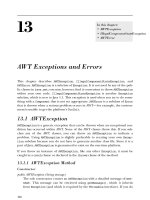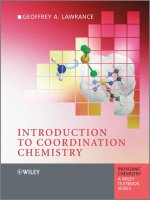Introduction to physical chemistry acid base and solution equilibira
Bạn đang xem bản rút gọn của tài liệu. Xem và tải ngay bản đầy đủ của tài liệu tại đây (8.67 MB, 74 trang )
JF Chemistry 1101 2011
Introduction to Physical
Chemistry:
Acid Base and Solution
Equilibria.
Dr Mike Lyons
School of Chemistry
Required Reading Material.
• Silberberg, Chemistry, 4th edition.
– Chapter 18.
• Acid/base equilibria. pp.766-813.
– Chapter 19.
• Ionic equilibria in aqueous systems. pp.814-862.
• Kotz, Treichel and Weaver, 7th edition.
– Chapter 17 (Chemistry of Acids and Bases) &
Chapter18 (Principles of reactivity: other aspects
of ionic equilibria), pp.760-859.
• Chemistry3, Burrows et al.
– Chapter 6, Acids & bases, pp.263-299.
1
Review : Kotz Chapter 3 for simple acid/base
definitions.
Lecture 13.
Acid/base chemistry :
Simple ideas: Arrhenius,
Bronsted-Lowry, Lewis.
Kotz: section 3.7, pp.131-139.
Section 17.1, pp.761-762.
Acid and Bases
2
Acid and Bases
Acid and Bases
3
Arrhenius (or Classical) Acid-Base
Definition
•
•
•
•
•
An acid is a neutral substance
that contains hydrogen and
dissociates or ionizes in water
to yield hydrated protons or
hydronium ions H3O+.
A base is a neutral substance
that contains the hydroxyl group
and dissociates in water to yield
hydrated hydroxide ions OH -.
Neutralization is the reaction of
an H+ (H3O+) ion from the acid
and the OH - ion from the base
to form water, H2O.
These definitions although
correct are limited in that they
are not very general and do not
Give a comprehensive idea of
what acidity and basicity entails.
HCl → H + ( aq) + Cl − (aq )
NaOH → Na + (aq ) + OH − ( aq)
HCl + NaOH → NaCl + H 2O
Arrhenius acid is a substance that produces H+ (H3O+) in water.
Arrhenius base is a substance that produces OH- in water.
4
Acids and bases:
Bronsted/Lowry definition.
•
Bronsted/Lowry Acid (HA):
– An acid is a species which
donates a proton
•
Bronsted/Lowry Base (B):
– A base is a species which
accepts a proton.
•
These definitions are quite
general and refer to the
reaction between an acid and a
base.
•
An acid must contain H in its
formula; HNO3 and H2PO4- are two
examples, all Arrhenius acids are
Brønsted-Lowry acids.
A base must contain a lone pair of
electrons to bind the H+ ion; a few
examples are NH3, CO32-, F -, as well
as OH -. Brønsted-Lowry bases are
not Arrhenius bases, but all
Arrhenius bases contain the
Brønsted-Lowry base OH-.
•
• In the Brønsted-Lowry perspective:
one species donates a proton and
another species accepts it: an acidbase reaction is a proton transfer
process.
Chemistry3 section 6.1. pp.264-267.
Kotz 7th ed. Section 17.1. pp.761-765
BL acid/base equilibria.
BL base
BL acid
H3O+ (aq) + A- (aq)
Proton transfer
BL acid
HA(aq) + H2O (l)
Water can function
both as an acid
and a base
depending on the
circumstances.
HB+ (aq) + OH- (aq)
BL base B (aq) + H2O (l)
• Proton donation and acceptance are dynamic processes for all acids
and bases. Hence a proton transfer equilibrium is rapidly established
in solution.
• The equilibrium reaction is described in terms of conjugate acid/base
pairs.
• The conjugate base (CB) of a BL acid is the base which forms when the
acid has donated a proton.
• The conjugate acid (CA) of a BL base is the acid which forms when the
base has accepted a proton.
• A conjugate acid has one more proton than the base has, and a
conjugate base one less proton than the acid has.
• If the acid of a conjugate acid/base pair is strong (good tendency to
donate a proton) then the conjugate base will be weak (small
tendency to accept a proton) and vice versa.
Acid : proton donor
Base : proton acceptor
Proton transfer
HA (aq) + B (aq)
A
B
BH+ (aq) + A- (aq)
CA
CB
5
A Brønsted acid is a proton donor
A Brønsted base is a proton acceptor
base
acid
acid
base
base
acid
conjugate
acid
conjugate
base
15.1
Brønsted-Lowry Acid-Base Definition
An acid is a proton donor, any species which donates a H+.
A base is a proton acceptor, any species which accepts a H+.
An acid-base reaction can now be viewed from the
standpoint of the reactants AND the products.
An acid reactant will produce a base product and the two
will constitute an acid-base conjugate pair.
6
Table 18.4 The Conjugate Pairs in Some Acid-Base Reactions
Conjugate Pair
Acid
+
Base
Base
+
Acid
Conjugate Pair
Reaction 1
HF
+
H2O
F-
+
H3O+
Reaction 2
HCOOH +
CN-
HCOO-
+
HCN
Reaction 3
NH4+
+
CO32-
NH3
+
HCO3-
Reaction 4
H2PO4-
+
OH-
HPO42-
+
H2O
Reaction 5
H2SO4
+
N2H5+
HSO4-
+
N2H62+
Reaction 6
HPO42-
+
SO32-
PO43-
+
HSO3-
Copyright © The McGraw-Hill Companies, Inc. Permission required for reproduction or display.
15.4
7
SAMPLE PROBLEM 18.4:
PROBLEM:
Identifying Conjugate Acid-Base Pairs
The following reactions are important environmental processes.
Identify the conjugate acid-base pairs.
(a) H2PO4-(aq) + CO32-(aq)
(b) H2O(l) + SO32-(aq)
PLAN:
HPO42-(aq) + HCO3-(aq)
OH-(aq) + HSO3-(aq)
Identify proton donors (acids) and proton acceptors (bases).
conjugate pair2
conjugate pair
1
SOLUTION:
(a) H2PO4-(aq) + CO32-(aq)
proton
donor
proton
acceptor
HPO42-(aq) + HCO3-(aq)
proton
acceptor
conjugate pair2
conjugate pair1
(b) H2O(l) + SO32-(aq)
proton proton
donor acceptor
proton
donor
OH-(aq) + HSO3-(aq)
proton
acceptor
proton
donor
8
Strong and weak acids.
Strong acids dissociate completely into ions in water:
HA(g or l) + H2O(l)
H3O+(aq) + A-(aq)
In a dilute solution of a strong acid, almost no HA molecules
exist: [H3O+] = [HA]init or [HA]eq = 0
Qc =
[H3O+][A-]
[HA][H2O]
at equilibrium, Qc = Kc >> 1
Nitric acid is an example: HNO3 (l) + H2O(l)
H3O+(aq) + NO3-(aq)
Weak acids dissociate very slightly into ions in water:
HA(aq) + H2O(aq)
H3O+(aq) + A-(aq)
In a dilute solution of a weak acid, the great majority of HA
molecules are undissociated: [H3O+] << [HA]init or [HA]eq = [HA]init
Qc =
[H3O+][A-]
[HA][H2O]
The Extent of
Dissociation for
Strong and
Weak Acids
Key concept :
Acid/base strength
quantified in terms
of extent or degree
of dissociation.
An acid or base is
classified as strong
if it is fully ionized
in solution (e.g. HCl,
NaOH).
An acid or base is
classified as weak if
only a small fraction
is ionized in solution
(e.g. CH3COOH, NH3).
at equilibrium, Qc = Kc << 1
Complete ionization
Partial ionization
9
Extent of dissociation :
strong acid.
Copyright © The McGraw-Hill Companies, Inc. Permission required for reproduction or display.
Strong acid: HA(g or l) + H2O(l)
H3O+(aq) + A-(aq)
Extent of dissociation:
weak acid.
Copyright © The McGraw-Hill Companies, Inc. Permission required for reproduction or display.
Weak acid: HA(aq) + H2O(l)
H3O+(aq) + A-(aq)
10
Reactivity of strong and weak acids.
1M HCl(aq)
1M CH3COOH(aq)
Classifying the Relative Strengths of Acids.
Strong acids.
There are two types of strong acids:
•The hydrohalic acids HCl, HBr, and HI
•Oxoacids in which the number of O atoms exceeds the number of
ionizable H atoms by two or more, such as HNO3, H2SO4, HClO4
Weak acids.
There are many more weak acids than strong ones. Four
types, with examples, are:
• The hydrohalic acid HF
• Those acids in which H is bounded to O or to halogen, such as
HCN and H2S
• Oxoacids in which the number of O atoms equals or exceeds by one
the number of ionizable H atoms, such as HClO, HNO2, and H3PO4
• Organic acids (general formula RCOOH), such as CH3COOH and
C6H5COOH.
11
Classifying the Relative Strengths of Bases.
Strong bases.
• Soluble compounds containing O2- or OH- ions are strong
bases. The cations are usually those of the most active metals:
M2O or MOH, where M= Group 1A(1) metals (Li, Na, K, Rb, Cs).
• MO or M(OH)2, where M = Group 2A(2) metals (Ca, Sr, Ba)
[MgO and Mg(OH)2 are only slightly soluble, but the soluble
portion dissociates completely.]
Weak bases.
• Many compounds with an electron-rich nitrogen are weak
bases (none are Arrhenius bases). The common structural feature
is an N atom that has a lone electron pair in its Lewis structure.
• Ammonia (NH3)
• Amines (general formula RNH2, R2NH, R3N), such as
CH3CH2NH2, (CH3)2NH, (C3H7)3N, and C5H5N
Strong Electrolyte – 100% dissociation
NaCl (s)
H2O
Na+ (aq) + Cl- (aq)
Weak���������������������������������������������������������������������������������������������������������������������������������������������������������������������������������������������������������������������������������������������������������������������������������������������������������������������������������������������������������������������������������������������������������������������������������������������������������������������������������������������������������������������������������������������������������������������������������������������������������������������������������������������������������������������������������������������������������������������������������������������������������������������������������������������������������������������������������������������������������������������������������������������������������������������������������������������������������������������������������������������������������������������������������������������������������������������������������������������������������������������������������������������������������������������������������������������������������������������������������������������������������������������������������������������������������������������������������������������������������������������������������������������������������������������������������������������������������������������������������������������������������������������������������������������������������������������������������������������������������������������������������������������������������������������������������������������������������������������������������������������������������������������������������������������������������������������������������������������������������������������������������������������������������������������������������������������������������������������������������������������������������������������������������������������������������������������������������������������������������������������������������������������������������������������������������������������������������������������������������������������������������������������������������������������������������������������������������������������������������������������������������������������������������������������������������������������������������������������������������������������������������������������������������������������������������������������������������������������������������������������������������������������������������������������������������������������������������������������������������������������������������������������������������������������������������������������������������������������������������������������������������������������������������������������������������������������������������������������������������������������������������������������������������������������������������������������������������������������������������������������������������������������������������������������������������������������������������������������������������������������������������������������������������������������������������������������������������������������������������������������������������������������������������������������������������������������������������������������������������������������������������������������������������������������������������������������������������������������������������������������������������������������������������������������������������������������������������������������������������������������������������������������������������������������������������������������������������������������������������������������������������������������������������������������������������������������������������������������������������������������������������������������������������������������������������������������������������������������������������������������������������������������������������������������������������������������������������������������������������������������������������������������������������������������������������������������������������������������������������������������������������������������������������������������������������������������������������������������������������������������������������������������������������������������������������������������������������������������������������������������������������������������������������������������������������������������������������������������������������������������������������������������������������������������������������������������������������������������������������������������������������������������������������������������������������������������������������������������������������������������������������������������������������������������������������������������������������������������������������������������������������������������������������������������������������������������������������������������������������������������������������������������������������������������������������������������������������������������������������������������������������������������������������������������������������������������������������������������������������������������������������������������������������������������������������������������������������������������������������������������������������������������������������������������������������������������������������������������������������������������������������������������������������������������������������������������������������������������������������������������������������������������������������������������������������������������������������������������������������������������������������������������������������������������������������������������������������������������������������������������������������������������������������������������������������������������������������������������������������������������������������������������������������������������������������������������������������������������������������������������������������������������������������������������������������������������������������������������������������������������������������������������������������������������������������������������������������������������������������������������������������������������������������������������������������������������������������������������������������������������������������������������������������������������������������������������������������������������������������������������������������������������������������������������������������������������������������������������������������������������������������������������������������������������������������������������������������������������������������������������������������������������������������������������������������������������������������������������������������������������������������������������������������������������������������������������������������������������������������������������������������������������������������������������������������������������������������������������������������������������������������������������������������������������������������������������������������������������������������������������������������������������������������������������������������������������������������������������������������������������������������������������������������������������������������������������������������������������������������������������������������������������������������������������������������������������������������������������������������������������������������������������������������������������������������������������������������������������������������������������������������������������������������������������������������������������������������������������������������������������������������������������������������������������������������������������������������������������������������������������������������������������������������������������������������������������������������������������������������������������������������������������������������������������������������������������������������������������������������������������������������������������������������������������������������������������������������������������������������������������������������������������������������������������������������������������������������������������������������������������������������������������������������������������������������������������������������������������������������������������������������������������������������������������������������������������������������������������������������������������������������������������������������������������������������������������������������������������������������������������������������������������������������������������������������������������������������������������������������������������������������������������������������������������������������������������������������������������������������������������������������������������������������������������������������������������������������������������������������������������������������������������������������������������������������������������������������������������������������������������������������������������������������������������������������������������������������������������������������������������������������������������������������������������������������������������������������������������������������������������������������������������������������������������������������������������������������������������������������������������������������������������������������������������������������������������������������������������������������������������������������������������������������������������������������������������������������������������������������������������������������������������������������������������������������������������������������������������������������������������������������������������������������������������������������������������������������������������������������������������������������������������������������������������������������������������������������������������������������������������������������������������������������������������������������������������������������������������������������������������������������������������������������������������������������������������������������������������������������������������������������������������������������������������������������������������������������������������������������������������������������������������������������������������������������������������������������������������������������������������������������������������������������������������������������������������������������������������������������������������������������������������������������������������������������������������������������������������������������������������������������������������������������������������������������������������������������������������������������������������������������������������������������������������������������������������������������������������������������������������������������������������������������������������������������������������������������������������������������������������������������������������������������������������������������������������������������������������������������������������������������������������������������������������������������������������������������������������������������������������������������������������������������������������������������������������������������������������������������������������������������������������������������������������������������������������������������������������������������������������������������������������������������������������������������������������������������������������������������������������������������������������������������������������������������������������������������������������������������������������������������������������������������������������������������������������������������������������������������������������������������������������������������������������������������������������������������������������������������������������������������������������������������������������������������������������������������������������������������������������������������������������������������������������������������������������������������������������������������������������������������������������������������������������������������������������������������������������������������������������������������������������������������������������������������������������������������������������������������������������������������������������������������������������������������������������������������������������������������������������������������������������������������������������������������������������������������������������������������������������������������������������������������������������������������������������������������������������������������������������������������������������������������������������������������������������������������������������������������������������������������������������������������������������������������������������������������������������������������������������������������������������������������������������������������������������������������������������������������������������������������������������������������������������������������������������������������������������������������������������������������������������������������������������������������������������������������������������������������������������������������������������������������������������������������������������������������������������������������������������������������������������������������������������������������������������������������������������������������������������������������������������������������������������������������������������������������������������������������������������������������������������������������������������������������������������������������������������������������������������������������������������������������������������������������������������������������������������������������������������������������������������������������������������������������������������������������������������������������������������������������������������������������������������������������������������������������������������������������������������������������������������������������������������������������������������������������������������������������������������������������������������������������������������������������������������������������������������������������������������������������������������������������������������������������������������������������������������������������������������������������������������������������������������������������������������������������������������������������������������������������������������������������������������������������������������������������������������������������������������������������������������������������������������������������������������������������������������������������������������������������������������������������������������������������������������������������������������������������������������������������������������������������������������������������������������������������������������������������������������������������������������������������������������������������������������������������������������������������������������������������������������������������������������������������������������������������������������������������������������������������������������������������������������������������������������������������������������������������������������������������������������������������������������������������������������������������������������������������������������������������������������������������������������������������������������������������������������������������������������������������������������������������������������������������������������������������������������������������������������������������������������������������������������������������������������������������������������������������������������������������������������������������������������������������������������������������������������������������������������������������������������������������������������������������������������������������������������������������������������������������������������������������������������������������������������������������������������������������������������������������������������������������������������������������������������������������������������������������������������������������������������������������������������������������������������������������������������������������������������������������������������������������������������������������������������������������������������������������������������������������������������������������������������������������������������������������������������������������������������������������������������������������������������������������������������������������������������������������������������������������������������������������������������������������������������������������������������������������������������������������������������������������������������������������������������������������������������������������������������������������������������������������������������������������������������������������������������������������������������������������������������������������������������������������������������������������������������������������������������������������������������������������������������������������������������������������������������������������������������������������������������������������������������������������������������������������������������������������������������������������������������������������������������������������������������������������������������������������������������������������������������������������������������������������������������������������������������������������������������������������������������������������������������������������������������������������������������������������������������������������������������������������������������������������������������������������������������������������������������������������������������������������������������������������������������������������������������������������������������������������������������������������������������������������������������������������������������������������������������������������������������������������������������������������������������������������������������������������������������������������������������������������������������������������������������������������������������������������������������������������������������������������������������������������������������������������������������������������������������������������������������������������������������������������������������������������������������������������������������������������������������������������������������������������������������������������������������������������������������������������������������������������������������������������������������������������������������������������������������������������������������������������������������������������������������������������������������������������������������������������������������������������������������������������������������������������������������������������������������������������������������������������������������������������������������������������������������������������������������������������������������������������������������������������������������������������������������������������������������������������������������������������������������������������������������������������������������������������������������������������������������������������������������������������������������������������������������������������������������������������������������������������������������������������������������������������������������������������������������������������������������������������������������������������������������������������������������������������������������������������������������������������������������������������������������������������������������������������������������������������������������������������������������������������������������������������������������������������������������������������������������������������������������������������������������������������������������������������������������������������������������������������������������������������������������������������������������������������������������������������������������������������������������������������������������������������������������������������������������������������������������������������������������������������������������������������������������������������������������������������������������������������������������������������������������������������������������������������������������������������������������������������������������������������������������������������������������������������������������������������������������������������������������������������������������������������������������������������������������������������������������������������������������������������������������������������������������������������������������������������������������������������������������������������������������������������������������������������������������������������������������������������������������������������������������������������������������������������������������������������������������������������������������������������������������������������������������������������������������������������������������������������������������������������������������������������������������������������������������������������������������������������������������������������������������������������������������������������������������������������������������������������������������������������������������������������������������������������������������������������������������������������������������������������������������������������������������������������������������������������������������������������������������������������������������������������������������������������������������������������������������������������������������������������������������������������������������������������������������������������������������������������������������������������������������������������������������������������������������������������������������������������������������������������������������������������������������������������������������������������������������������������������������������������������������������������������������������������������������������������������������������������������������������������������������������������������������������������������������������������������������������������������������������������������������������������������������������������������������������������������������������������������������������������������������������������������������������������������������������������������������������������������������������������������������������������������������������������������������������������������������������������������������������������������������������������������������������������������������������������������������������������������������������������������������������������������������������������������������������������������������������������������������������������������������������������������������������������������������������������������������������������������������������������������������������������������������������������������������������������������������������������������������������������������������������������������������������������������������������������������������������������������������������������������������������������������������������������������������������������������������������������������������������������������������������������������������������������������������������������������������������������������������������������������������������������������������������������������������������������������������������������������������������������������������������������������������������������������������������������������������������������������������������������������������������������������������������������������������������������������������������������������������������������������������������������������������������������������������������������������������������������������������������������������������������������������������������������������������������������������������������������������������������������������������������������������������������������������������������������������������������������������������������������������������������������������������������������������������������������������������������������������������������������������������������������������������������������������������������������������������������������������������������������������������������������������������������������������������������������������������������������������������������������������������������������������������������������������������������������������������������������������������������������������������������������������������������������������������������������������������������������������������������������������������������������������������������������������������������������������������������������������������������������������������������������������������������������������������������������������������������������������������������������������������������������������������������������������������������������������������������������������������������������������������������������������������������������������������������������������������������������������������������������������������������������������������������������������������������������������������������������������������������������������������������������������������������������������������������������������������������������������������������������������������������������������������������������������������������������������������������������������������������������������������������������������������������������������������������������������������������������������������������������������������������������������������������������������������������������������������������������������������������������������������������������������������������������������������������������������������������������������������������������������������������������������������������������������������������������������������������������������������������������������������������������������������������������������������������������������������������������������������������������������������������������������������������������������������������������������������������������������������������������������������������������������������������������������������������������������������������������������������������������������������������������������������������������������������������������������������������������������������������������������������������������������������������������������������������������������������������������������������������������������������������������������������������������������������������������������������������������������������������������������������������������������������������������������������������������������������������������������������������������������������������������������������������������������������������������������������������������������������������������������������������������������������������������������������������������������������������������������������������������������������������������������������������������������������������������������������������������������������������������������������������������������������������������������������������������������������������������������������������������������������������������������������������������������������������������������������������������������������������������������������������������������������������������������� H2O
– Precipitation:
Pb(NO3) 2 + 2 KI PbI2(s) + 2 KNO3
• OXIDATION REDUCTION
– 4 Fe + 3 O2 2 Fe2O3
• Apply equilibrium principles to acidacid-base and
precipitation reactions.
Analysis of Silver Group
Ag+ Pb2+ Hg22+
AgCl PbCl 2 Hg2Cl2
All salts formed in this
experiment are said to
be INSOLUBLE and
form when mixing
moderately
concentrated solutions
of the metal ion with
chloride ions.
PLAY MOVIE
63
Ag+ Pb2+ Hg22+
AgCl PbCl2 Hg2Cl2
Analysis of
Silver Group
Although all salts formed in this experiment are said
to be insoluble, they do dissolve to some SLIGHT
extent.
AgCl(s)
Ag+(aq) + Cl-(aq)
When equilibrium has been established, no more
AgCl dissolves and the solution is SATURATED.
Ag+ Pb2+ Hg22+
AgCl PbCl2 Hg2Cl2
AgCl(s)
Analysis of
Silver Group
Ag+(aq) + Cl-(aq)
Kc = [Ag+] [Cl-] = 2.79 x 10-10
Because this is the product of “solubilities”,
we call it
Ksp = solubility product constant
• See Kotz,Table 18.2 and Appendix J
64
Ag+ Pb2+ Hg22+
AgCl PbCl2 Hg2Cl2
AgCl(s)
Analysis of
Silver Group
Ag+(aq) + Cl-(aq)
When solution is SATURATED, expt. shows that
[Ag+] = 1.67 x 10-5 M.
This is equivalent to the SOLUBILITY of AgCl.
What is [Cl-]?
[Cl-] = [Ag+] = 1.67 x 10-5 M
Ag+ Pb2+ Hg22+
AgCl PbCl2 Hg2Cl2
AgCl(s)
Analysis of
Silver Group
Ag+(aq) + Cl-(aq)
Saturated solution has
[Ag+] = [Cl-] = 1.67 x 10-5 M
Use this to calculate Kc
Kc = [Ag+] [Cl-]
= (1.67 x 10-5)(1.67 x 10-5)
= 2.79 x 10-10
65
Some Values of Ksp
Table 18.2 and Appendix J
Lead(II) Chloride
PbCl2(s)
Pb2+(aq) + 2 Cl-(aq)
Ksp = 1.9 x 10-5 = [Pb2+][Cl–]2
PLAY MOVIE
66
Solubility of Lead(II) Iodide
Consider PbI2 dissolving in water
Pb2+(aq) + 2 I-(aq)
PbI2(s)
Calculate Ksp
if solubility = 0.00130 M
Solution
1. Solubility = [Pb2+] = 1.30 x 10-3 M
[I-] = ?
[I-] = 2 x [Pb2+] = 2.60 x 10-3 M
Solubility of Lead(II) Iodide
Consider PbI2 dissolving in water
PbI2(s)
Pb2+(aq) + 2 I-(aq)
Calculate Ksp
if solubility = 0.00130 M
Solution
2. Ksp = [Pb2+] [I-]2
= [Pb2+] {2 • [Pb2+]}2
Ksp = 4 [Pb2+]3 = 4 (solubility)3
Ksp = 4 (1.30 x 10-3)3 = 8.79 x 10-9
67
Precipitating an Insoluble Salt
Hg2Cl2(s)
Hg22+(aq) + 2 Cl-(aq)
Ksp = 1.1 x 10-18 = [Hg22+] [Cl-]2
If [Hg22+] = 0.010 M, what [Cl-] is req’d
to just begin the precipitation of
Hg2Cl2?
That is, what is the maximum [Cl-] that
can be in solution with 0.010 M Hg22+
without forming Hg2Cl2?
Precipitating an Insoluble Salt
Hg2Cl2(s)
Hg22+(aq) + 2 Cl-(aq)
Ksp = 1.1 x 10-18 = [Hg22+] [Cl-]2
Recognize that
Ksp = product of
maximum ion concs.
Precip. begins when product of
ion concs. EXCEEDS the Ksp.
68
Precipitating an Insoluble Salt
Hg2Cl2(s)
Hg22+(aq) + 2 Cl-(aq)
Ksp = 1.1 x 10-18 = [Hg22+] [Cl-]2
Solution
[Cl-] that can exist when [Hg22+] = 0.010 M,
K sp
[Cl- ] =
0.010
= 1.1 x 10-8 M
If this conc. of Cl- is just exceeded, Hg2Cl2
begins to precipitate.
Precipitating an Insoluble Salt
Hg2Cl2(s)
Hg22+(aq) + 2 Cl-(aq)
Ksp = 1.1 x 10-18
Now raise [Cl-] to 1.0 M. What is the value of [Hg22+] at
this point?
Solution
[Hg22+] = Ksp / [Cl-]2
= Ksp / (1.0)2 = 1.1 x 10-18 M
The concentration of Hg22+ has been reduced by 1016 !
69
The Common Ion Effect
Adding an ion “common” to an equilibrium
causes the equilibrium to shift back to
reactant.
Common Ion Effect
PbCl2(s)
Pb2+(aq) + 2 Cl-(aq)
Ksp = 1.9 x 10-5
PLAY MOVIE
70
Barium Sulfate
Ksp = 1.1 x 10-10
(a) BaSO4 is a common
mineral, appearing a
white powder or
colorless crystals.
(b) BaSO4 is opaque
to x-rays. Drinking
a BaSO4 cocktail
enables a physician
to exam the
intestines.
The Common Ion Effect
Calculate the solubility of BaSO4 in (a) pure
water and (b) in 0.010 M Ba(NO3)2.
Ksp for BaSO4 = 1.1 x 10-10
BaSO4(s)
Ba2+(aq) + SO42-(aq)
Solution (a)
Solubility in pure water = [Ba2+] = [SO42-] = x
Ksp = [Ba2+] [SO42-] = x2
x = (Ksp)1/2 = 1.1 x 10-5 M
Solubility in pure water = 1.0 x 10-5 mol/L
71
The Common Ion Effect
Calculate the solubility of BaSO4 in (a) pure water and (b)
in 0.010 M Ba(NO3)2.
Ksp for BaSO4 = 1.1 x 10-10
BaSO4(s)
Ba2+(aq) + SO42-(aq)
Solution (b)
Solubility in pure water = 1.1 x 10-5 mol/L.
Now dissolve BaSO4 in water already containing 0.010 M
Ba2+.
Which way will the “common ion” shift the equilibrium?
Will solubility of BaSO4 be less than or greater than in
pure water?
The Common Ion Effect
Solution (b) cont.
[Ba2+]
0.010
initial
+y
change
0.010 + y
equilib.
[SO42-]
0
+y
y
Ksp = [Ba2+] [SO42-] = (0.010 + y) (y)
Because y < 1.1 x 10-5 M (= x, the solubility in pure water), this
means 0.010 + y is about equal to 0.010. Therefore,
Ksp = 1.1 x 10-10 = (0.010)(y)
y = 1.1 x 10-8 M = solubility in presence of added Ba2+ ion.
SUMMARY
Solubility in pure water = x = 1.1 x 10-5 M
Solubility in presence of added Ba2+ = 1.1 x 10-8 M
Le Chatelier’s Principle is followed!
72
Separating Metal Ions
Cu2+, Ag+, Pb2+
Ksp Values
AgCl
1.8 x 10-10
PbCl2
1.7 x 10-5
PbCrO4
1.8 x 10-14
PLAY MOVIE
Kotz, section 18.5, pp. 842-845
Separating Salts by Differences in Ksp
A solution contains 0.020 M Ag+ and Pb2+. Add CrO42- to
precipitate red Ag2CrO4 and yellow PbCrO4. Which
precipitates first?
Ksp for Ag2CrO4 = 9.0 x 10-12
Ksp for PbCrO4 = 1.8 x 10-14
Solution
The substance whose Ksp is first
exceeded precipitates first.
The ion requiring the lesser amount of
CrO42- ppts. first.
73
Separating Salts by Differences in Ksp
A solution contains 0.020 M Ag+ and Pb2+. Add CrO42- to precipitate red
Ag2CrO4 and yellow PbCrO4. Which precipitates first?
Ksp for Ag2CrO4 = 9.0 x 10-12
Ksp for PbCrO4 = 1.8 x 10-14
Solution
Calculate [CrO42-] required by each ion.
[CrO42-] to ppt. PbCrO4 = Ksp / [Pb2+]
= 1.8 x 10-14 / 0.020 = 9.0 x 10-13 M
[CrO42-] to ppt. Ag2CrO4 = Ksp / [Ag+]2
= 9.0 x 10-12 / (0.020)2 = 2.3 x 10-8 M
PbCrO4 precipitates first
Forming and dissolving precipitates: insoluble compounds often dissolve on
Adding a suitable complexing agent.
Kotz, section 18.6, pp.846-848
74









